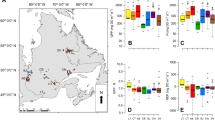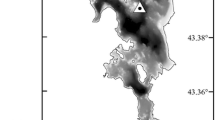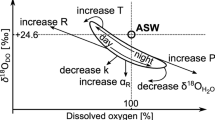Abstract
In remote regions of the world, whole lake metabolic estimates are scarce, largely because long incubations, intensive sampling and deployment of monitoring equipment are impractical. The oxygen isotope (δ18O) mass balance approach represents a simple and efficient alternative to measure whole-lake gross primary production (GPP) and respiration (R) from a single point sample, yet this option has not been extensively explored in habitats such as remote northern lakes. Here, we explored the applicability of the method using a sensitivity analysis on simulated data, showing that in large, heterotrophic (i.e., R > GPP) lakes, model outputs are sensitive to input terms for isotopic fractionation and air–water gas exchange. Despite these sensitivities, field applications of the δ18O method generated promising results that were generally consistent with parallel, free-water diel DO metabolic modelling, but greater than in vitro incubation measurements. The isotopic approach captured both wide-ranging metabolic conditions in in situ experimental mesocosms, and the seasonal trends in GPP and R in a shallow, dystrophic lake. In a clearer, deeper heterotrophic lake, the isotope approach integrated a fraction of metalimnetic metabolism missed by diel DO metabolic estimates. Overall, metalimnetic contributions to surface δ18O–DO dynamics had the greatest impact on model outputs, but with accurate information on air–water gas exchange, mixing depth, and the vertical DO and light regime of a given system, these effects can be accounted for and the isotopic approach can yield well constrained, spatio-temporally integrated rates of GPP and R. The approach is clearly suitable for use in oligo- and mesotrophic lakes, especially in remote regions where sampling is logistically difficult.








Similar content being viewed by others
References
Allen AP, Gillooly JF, Brown JH (2005) Linking the global carbon cycle to individual metabolism. Funct Ecol 19:202–213
Ask J, Karlsson J, Jansson M (2012) Net ecosystem production in clear water and brown water lakes. Global Biogeochem Cycles 26:GB1017
Barkan E, Luz B (2005) High precision measurements of 17O/16O and 18O/16O ratios in H2O. Rapid Commun Mass Spectrom 19:3737–3742
Barth JA, Tait A, Bolshaw M (2004) Automated analyses of 18O/16O ratios in dissolved oxygen from 12-mL water samples. Limnol Oceanogr Meth 2:35–41
Bender ML (1990) The δ18O of dissolved O2 in seawater: a unique tracer of circulation and respiration in the deep sea. J Geophys Res-Oceans 95:22243–22252
Bender ML, Grande KD (1987) Production, respiration, and the isotope geochemistry of O2 in the upper water column. Global Biogeochem Cycles 1:49–59
Bender M, Orchardo J, Dickson ML, Barber R, Lindley S (1999) In vitro O2 fluxes compared with 14C production and other rate terms during the JGOFS Equatorial Pacific experiment. Deep-Sea Res Pt I 46:637–654
Benson BB, Krause D (1984) The concentration and isotopic fractionation of oxygen dissolved in freshwater and seawater in equilibrium with the atmosphere. Limnol Oceanogr 29:620–632
Bocaniov SA, Schiff SL, Smith RE (2012) Plankton metabolism and physical forcing in a productive embayment of a large oligotrophic lake: insights from stable oxygen isotopes. Freshw Biol 57:481–496
Bocaniov SA, Schiff SL, Smith RE (2015) Non steady-state dynamics of stable oxygen isotopes for estimates of metabolic balance in large lakes. J Great Lakes Res 41:719–729
Bogard MJ, del Giorgio PA, Boutet L, Chaves MCG, Prairie YT, Merante A, Derry AM (2014) Oxic water column methanogenesis as a major component of aquatic CH4 fluxes. Nat Commun 5:5350
Borges A, Delille B, Schiettecatte LS, Gazeau F, Abril G, Frankignoulle M (2004) Gas transfer velocities of CO2 in three European estuaries (Randers Fjord, Scheldt and Thames). Limnol Oceanogr 49:1630–1641
Bouvier TC, del Giorgio PA (2002) Compositional changes in free-living bacterial communities along a salinity gradient in two temperate estuaries. Limnol Oceanogr 47:453–470
Brandes JA, Devol AH (1997) Isotopic fractionation of oxygen and nitrogen in coastal marine sediments. Geochim Cosmochim Acta 61:1798–1801
Cantin A, Beisner BE, Gunn JM, Prairie YT, Winter JG (2011) Effects of thermocline deepening on lake plankton communities. Can J Fish Aquat Sci 68:260–276
Carignan R, Planas D, Vis C (2000) Planktonic production and respiration in oligotrophic Shield lakes. Limnol Oceanogr 45:189–199
Chomicki KM, Schiff SL (2008) Stable oxygen isotopic fractionation during photolytic O2 consumption in stream waters. Sci Tot Environ 404:236–244
Cole JJ, Caraco NF (1998) Atmospheric exchange of carbon dioxide in a low-wind oligotrophic lake measured by the addition of SF6. Limnol Oceanogr 43:647–656
Cole JJ, Pace ML, Carpenter SR, Kitchell JF (2000) Persistence of net heterotrophy in lakes during nutrient addition and food web manipulations. Limnol Oceanogr 45:1718–1730
Cory RM, Ward CP, Crump BC, Kling GW (2014) Sunlight controls water column processing of carbon in arctic fresh waters. Science 345:925–928
del Giorgio PA, Williams PJLB (2005) The global significance of respiration in aquatic ecosystems: from single cells to the biosphere. In: del Giorgio PA, Williams PJLB (eds) Respiration in aquatic ecosystems. Oxford, New York, pp 267–303
den Heyer C, Kalff J (1998) Organic matter mineralization rates in sediments: a within-and among-lake study. Limnol Oceanogr 43:695–705
Downing JA, Rath LC (1988) Spatial patchiness in the lacustrine sedimentary environment. Limnol Oceanogr 33:447–458
Downing JA et al (2006) The global abundance and size distribution of lakes, ponds, and impoundments. Limnol Oceanogr 51:2388–2397
Dubois K, Carignan R, Veizer J (2009) Can pelagic net heterotrophy account for carbon fluxes from eastern Canadian lakes? Appl Geochem 24:988–998
Forget MH, Carignan R, Hudon C (2009) Influence of diel cycles of respiration, chlorophyll, and photosynthetic parameters on the summer metabolic balance of temperate lakes and rivers. Can J Fish Aquat Sci 66:1048–1058
Gat JR (1996) Oxygen and hydrogen isotopes in the hydrologic cycle. Annu Rev Earth Planet Sci 24:225–262
Goldman JA, Kranz SA, Young JN, Tortell PD, Stanley RH, Bender ML, Morel FM (2015) Gross and net production during the spring bloom along the Western Antarctic Peninsula. New Phytol 205:182–191
Granéli W, Lindell MS, Tranvik LJ (1996) Photo-oxidative production of dissolved inorganic carbon in lakes of different humic content. Limnol Oceanogr 41:698–706
Guillemette F, McCallister SL, del Giorgio PA (2013) Differentiating the degradation dynamics of algal and terrestrial carbon within complex natural dissolved organic carbon in temperate lakes. J Geophys Res Biogeo 118:963–973
Guy RD, Fogel ML, Berry JA (1993) Photosynthetic fractionation of the stable isotopes of oxygen and carbon. Plant Physiol 101:37–47
Hanson PC, Bade DL, Carpenter SR, Kratz TK (2003) Lake metabolism: relationships with dissolved organic carbon and phosphorus. Limnol Oceanogr 48:1112–1119
Hanson PC, Carpenter SR, Kimura N, Wu C, Cornelius SP, Kratz TK (2008) Evaluation of metabolism models for free-water dissolved oxygen methods in lakes. Limnol Oceanogr 6:454–465
Holtgrieve GW, Schindler DE, Branch TA, A’mar ZT (2010) Simultaneous quantification of aquatic ecosystem metabolism and reaeration using a Bayesian statistical model of oxygen dynamics. Limnol Oceanogr 55:1047–1063
Hotchkiss ER, Hall RO Jr (2014) High rates of daytime respiration in three streams: use of δ18OO2 and O2 to model diel ecosystem metabolism. Limnol Oceanogr 59:798–810
Jähne B, Münnich KO, Bösinger R, Dutzi A, Huber W, Libner P (1987) On the parameters influencing air-water gas exchange. J Geophys Res-Oceans 92:1937–1949
Jobin VO, Beisner BE (2014) Deep chlorophyll maxima, spatial overlap and diversity in phytoplankton exposed to experimentally altered thermal stratification. J Plankton Res 36:933–942
Jonsson A, Meili M, Bergström AK, Jansson M (2001) Whole-lake mineralization of allochthonous and autochthonous organic carbon in a large humic lake (Örträsket, N. Sweden). Limnol Oceanogr 46:1691–1700
Karlsson J, Byström P, Ask J, Ask P, Persson L, Jansson M (2009) Light limitation of nutrient-poor lake ecosystems. Nature 460:506–509
Kiddon J, Bender ML, Orchardo J, Caron DA, Goldman JC, Dennett M (1993) Isotopic fractionation of oxygen by respiring marine organisms. Global Biogeochem Cycles 7:679–694
Knox M, Quay PD, Wilbur D (1992) Kinetic isotopic fractionation during air–water gas transfer of O2, N2, CH4, and H2. J Geophys Res 97:20335–20343
Kortelainen P et al (2006) Sediment respiration and lake trophic state are important predictors of large CO2 evasion from small boreal lakes. Global Change Biol 12:1554–1567
Kroopnick P, Craig H (1972) Atmospheric oxygen: isotopic composition and solubility fractionation. Science 175:54–55
Lapierre JF, Seekell DA, del Giorgio PA (2015) Climate and landscape influence on indicators of lake carbon cycling through spatial patterns in dissolved organic carbon. Global Change Biol 21:4425–4435
Lehmann MF et al (2009) Aerobic respiration and hypoxia in the Lower St. Lawrence Estuary: stable isotope ratios of dissolved oxygen constrain oxygen sink partitioning. Limnol Oceanogr 54:2157–2169
Lennon JT, Hamilton SK, Muscarella ME, Grandy AS, Wickings K, Jones SE (2013) A source of terrestrial organic carbon to investigate the browning of aquatic ecosystems. PLoS ONE 8:e75771
Lewis WM Jr (2011) Global primary production of lakes: 19th Baldi Memorial Lecture. Inland Waters 1:1–28
Luz B, Barkan E (2000) Assessment of oceanic productivity with the triple-isotope composition of dissolved oxygen. Science 288:2028–2031
Luz B, Barkan E, Sagi Y, Yacobi YZ (2002) Evaluation of community respiratory mechanisms with oxygen isotopes: a case study in Lake Kinneret. Limnol Oceanogr 47:33–42
McCallister SL, del Giorgio PA (2008) Direct measurement of the δ13C signature of carbon respired by bacteria in lakes: linkages to potential carbon sources, ecosystem baseline metabolism, and CO2 fluxes. Limnol Oceanogr 53:1204–1216
Obrador B, Staehr PA, Christensen JP (2014) Vertical patterns of metabolism in three contrasting stratified lakes. Limnol Oceanogr 59:1228–1240
Ostrom NE, Russ ME, Field A, Piwinski L, Twiss MR, Carrick HJ (2005) Ratios of community respiration to photosynthesis and rates of primary production in Lake Erie via oxygen isotope techniques. J Great Lakes Res 31:138–153
Pace ML, Prairie YT (2005) Respiration in lakes. In: del Giorgio PA, Williams PJLB (eds) Respiration in aquatic ecosystems. Oxford, New York, pp 103–121
Parker SR, Poulson SR, Gammons CH, DeGrandpre MD (2005) Biogeochemical controls on diel cycling of stable isotopes of dissolved O2 and dissolved inorganic carbon in the Big Hole River, Montana. Environ Sci Technol 39:7134–7140
Pollard PC (2013) In situ rapid measures of total respiration rate capture the super labile DOC bacterial substrates of freshwater. Limnol Oceanogr 11:584–593
Quay PD, Emerson S, Wilbur DO, Stump C, Knox M (1993) The δ18O of dissolved O2 in the surface waters of the subarctic Pacific: a tracer of biological productivity. J Geophys Res 98:8447–8458
Quay PD, Wilbur D, Richey JE, Devol AH, Benner R, Forsberg BR (1995) The 18O:16O of dissolved oxygen in rivers and lakes in the Amazon Basin: determining the ratio of respiration to photosynthesis rates in freshwaters. Limnol Oceanogr 40:718–729
Quay PD, Peacock C, Björkman K, Karl DM (2010) Measuring primary production rates in the ocean: enigmatic results between incubation and non-incubation methods at Station ALOHA. Global Biogeochem Cycles 24:3
Quiñones-Rivera ZJ, Wissel B, Justic D, Fry B (2007) Partitioning oxygen sources and sinks in a stratified, eutrophic coastal ecosystem using stable oxygen isotopes. Mar Ecol Prog Ser 342:69–83
Quiñones-Rivera ZJ, Wissel B, Justić D (2009) Development of productivity models for the northern Gulf of Mexico based on oxygen concentrations and stable isotopes. Estuaries Coasts 32:436–446
Quiñones-Rivera ZJ, Finlay K, Vogt RJ, Leavitt PR, Wissel B (2015) Hydrologic, metabolic and chemical regulation of water-column metabolism and atmospheric CO2 exchange in a large continental reservoir during spring and summer. J Great Lakes Res 41:144–154
Read JS et al (2011) Derivation of lake mixing and stratification indices from high-resolution lake buoy data. Environ Modell Softw 26:1325–1336
Robidoux M, del Giorgio PA, Derry A (2015) Landscape-level variation among crustacean zooplankton lake populations in face of a humic stressor. Freshw Biol 60:1263–1278
Russ ME, Ostrom NE, Gandhi H, Ostrom PH, Urban NR (2004) Temporal and spatial variations in R:P ratios in Lake Superior, an oligotrophic freshwater environment. J Geophys Res 109:C10
Solomon CT et al (2013) Ecosystem respiration: drivers of daily variability and background respiration in lakes around the globe. Limnol Oceanogr 58:849–866
Staehr PA et al (2010) Lake metabolism and the diel oxygen technique: state of the science. Limnol Oceanogr-Meth 8:628–644
Staehr PA, Testa JM, Kemp WM, Cole JJ, Sand-Jensen K, Smith SV (2012) The metabolism of aquatic ecosystems: history, applications, and future challenges. Aquat Sci 74:15–29
Tobias CR, Böhlke JK, Harvey JW (2007) The oxygen-18 isotope approach for measuring aquatic metabolism in high productivity waters. Limnol Oceanogr 52:1439–1453
Vachon D, del Giorgio PA (2014) Whole-lake CO2 dynamics in response to storm events in two morphologically different lakes. Ecosystems 17:1338–1353
Vachon D, Prairie YT (2013) The ecosystem size and shape dependence of gas transfer velocity versus wind speed relationships in lakes. Can J Fish Aquat Sci 70:1757–1764
Vachon D, Prairie YT, Cole JJ (2010) The relationship between near-surface turbulence and gas transfer velocity in freshwater systems and its implications for floating chamber measurements of gas exchange. Limnol Oceanogr 55:1723–1732
Vachon D, Lapierre JF, del Giorgio PA (2016) Seasonality of photo-chemical dissolved organic carbon mineralization and its relative contribution to pelagic CO2 production in northern lakes. J Geophys Res Biogeo 121:864–878
Van de Bogert MC, Carpenter SR, Cole JJ, Pace ML (2007) Assessing pelagic and benthic metabolism using free water measurements. Limnol Oceanogr-Meth 5:145–155
Venkiteswaran JJ, Wassenaar LI, Schiff SL (2007) Dynamics of dissolved oxygen isotopic ratios: a transient model to quantify primary production, community respiration, and air–water exchange in aquatic ecosystems. Oecologia 153:385–398
Wang X, Depew D, Schiff S, Smith RE (2008) Photosynthesis, respiration, and stable isotopes of oxygen in a large oligotrophic lake (Lake Erie, USA-Canada). Can J Fish Aquat Sci 65:2320–2331
Wanninkhof R (1992) Relationship between wind speed and gas exchange over the ocean. J Geophys Res 97:7373–7382
Wassenaar LI (2012) Dissolved oxygen status of Lake Winnipeg: spatio-temporal and isotopic (δ18O–O 2) patterns. J Great Lakes Res 38:123–134
Wassenaar LI, Koehler G (1999) An on-line technique for the determination of the δ18O and δ17O of gaseous and dissolved oxygen. Anal Chem 71:4965–4968
Yang H, Andersen T, Dörsch P, Tominaga K, Thrane JE, Hessen DO (2015) Greenhouse gas metabolism in Nordic boreal lakes. Biogeochemistry 126:211–225
Acknowledgements
We thank Carolina Garcia Chaves, Simon Gauthier-Fautaux, Juan Pablo Nino Garcia, Cynthia Soued, Marilyne Robidoux, and Anthony Merante for field and laboratory assistance, and Alison Derry for use of the mesocosms. Annick St. Pierre, Alice Parks and the employees of the Station de biologie des Laurentides de l’Université de Montréal provided logistical support. We thank Amber Ulseth, Erin Hotchkiss, and Yves Prairie for helpful discussions on lake metabolism and the use of DO stable isotopes, Biel Obrador for providing published data, and Bob Hall plus one anonymous reviewer for providing constructive comments that improved the paper. M.J.B. was supported by doctoral grants from the National Science and Engineering Research Council of Canada (NSERC) and the Université du Québec a Montréal. This project is part of the program of the NSERC/HQ Industrial Research Chair in Carbon Biogeochemistry in Boreal Aquatic Systems (CarBBAS), co-funded by grants from NSERC and Hydro-Québec (to P.A.d.G.).
Author information
Authors and Affiliations
Corresponding author
Additional information
Responsible Editor: Charles T. Driscoll.
Electronic supplementary material
Below is the link to the electronic supplementary material.
Rights and permissions
About this article
Cite this article
Bogard, M.J., Vachon, D., St.-Gelais, N.F. et al. Using oxygen stable isotopes to quantify ecosystem metabolism in northern lakes. Biogeochemistry 133, 347–364 (2017). https://doi.org/10.1007/s10533-017-0338-5
Received:
Accepted:
Published:
Issue Date:
DOI: https://doi.org/10.1007/s10533-017-0338-5




